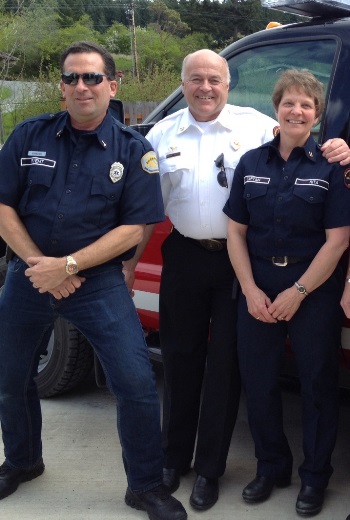— by Margie Doyle —
Orcas Island Fire and Rescue (OIFR) Chief Mik Preysz was confirmed as official Fire and Rescue Chief by the OIFR Board of Commissioners on November 19 (retroactive to October 16) after a six-month period as Interim Chief following the resignation of former Chief Kevin O’Brien last spring.
A career Deputy Sheriff, Firefighter, and Paramedic for nearly 39 years, Preysz has refined his leadership in those roles. Now in place at the helm of Orcas Fire and Rescue, he explains the recent streamlining of the department’s command structure and his plans to engage the community in a “new and different” Strategic Planning process.
Overall, his administration is determined to “engage all the members of OIFR to enable them to contribute substantially to the directions the department takes”, Preysz states.
The highest ranking OIFR Officers (the three Captains — Rita Harvey, Bob Nutt and Jim Schuh) now report directly to Chief Preysz’s for administrative matters. When responding to calls, our Duty Officers (Acting Deputy Chiefs, Scott Williams and Bryce Hamilton, and Battalion Chiefs, Patrick Shepler, and Nick Kiniski) will be the Officer in Charge and all responders will work in a clearly defined chain-of-command structure to provide services needed to patients at that time.
While in the act of responding on calls, Orcas Fire and Rescue is functioning in a direct chain of command outlined by rank, irrespective of volunteer or staff members. This is a necessity to ensure safety, communication, experience, and efficiency in handling emergencies for the community. Beyond that, all four of these individuals perform additional administrative duties when they are not called to service responses as well as when they are not on duty. In other words, they each have dedicated administrative duties when not on shift.
He says the secret to commanding respect is “always learning –no matter how much experience you have an individual can always add more; and recognizing caliber and allowing the better course of action to prevail. Then both the overall mission and the emergency situations are met by people who have vested interests in ownership of the solution and who trust the leaders to command.”
Preysz’s theories were validated by this past Nov. 22 and 23, when OIFR fought two house fires and organized relief efforts for the families involved within a 24-hour time period. He says without hesitation, “The crews did a superb job.”
Strategic Plan
Preysz signed a three-year contract this November, and he is already looking ahead to the creation of a Strategic Plan. We want: 1) To keep our community informed about what services OIFR presently provides, 2) To work with all healthcare providers and all our recipients of services to determine what needs are still unmet and 3) To create ways to meet them in the most efficient and cost effective manner possible .
“People want to live healthier lives and live here as long as we can, and not be flown off. Healthcare is changing, insurance is changing, and the community is changing. The questions that need to be addressed are basic: What do we want? Is there a cost or are community resources already available? How will we pay for it in terms dollars or volunteers? What other sources of revenue can we find other than the taxpayers’ dollar to meet the community’s needs.”
One example of this is the insurance Cost Recovery Program, approved by the Commissioners last summer and scheduled to begin this fall.
Another example is the SAFER grant, which provides for a Volunteer Coordinator for four years, started May of 2014. John Ahrens has held that position since this May, and Preysz says Ahrens is outstanding in the job because “He takes ownership; he strives to better himself by making sure he meets our volunteers requests and needs; and he has an expectation of excellence.”
The 2014 Fire and Rescue Levy passed voter approval and will be in effect until 2024. Preysz is determined to secure funding for the OIFR programs and initiatives without incurring additional taxpayer funds.
One key to coming up with creative, innovative, ideas and solutions, Preysz believes, is meeting together to have “fun in your own house, to brainstorm, to potluck, to get our community together to say what we think.”
He plans to reactivate a program within the schools, perhaps through the Career and Technical Education Program where students can contribute to the department and in turn be sponsored by OIFR/donations/community in their college education. The hoped-for outcome is that those students will return to the island with a commitment to the community following college graduation.
“The top priorities are responding to fire and medical calls, preparing for calls, including training, safety, and protecting the OIFR rating within the Washington Ratings Bureau, which significantly reduces property owners’ fire insurance rates”, Chief Preysz states. He says, “I’m honored by the support I’m getting. It is humbling to have people put their trust in us to help them”.
**If you are reading theOrcasonian for free, thank your fellow islanders. If you would like to support theOrcasonian CLICK HERE to set your modestly-priced, voluntary subscription. Otherwise, no worries; we’re happy to share with you.**









Mic, I appreciate you stepping up to Orcas Fire and Rescue. You have given us years of service in multiple levels. It’s fitting that you are now giving the biggest commitment of all.. Orcas Fire and Rescues Chief.
I am greatful for your attitude and commitment to our community’s needs.
Thank you, you will do well.
Clyde Duke.
Congratulations, Mik!